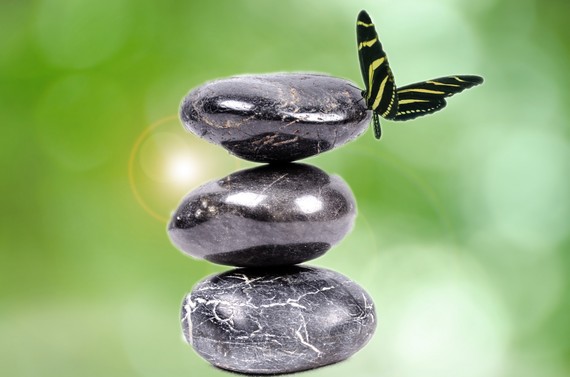(Over the past six months I have posted twice-monthly reflections on how intensive Buddhist meditation retreats offer a compass for everyday life. This column, concluding the current series, touches on the power of intentional silence).
A three-month Buddhist meditation retreat is no less mind-altering an experience than ingesting hallucinogens or traveling to a remote land where nobody speaks your language or knows your culture. But the agent (or angel) of revelation in intensive meditation is neither an exotic plant nor an expensive plane ticket. It is essentially this: silence.
Silence. Why bother saying (or writing) anything about it? Might as well cook a symphony, dance a landscape, embrace a fragrance. Attempting to describe silence with words should be an obvious non-starter - yet of course throughout written history, innumerable poems and tomes have been dedicated to its mysterious power. How human, our yearning to define and contain that which de facto lies beyond the purview of language.
On long retreats, shared communal silence is a basic way of life. As retreatants don the trappings of temporary monkhood, silence becomes a social norm, no more or less unusual than any other facet of group etiquette.
Still, the verbal mind, one quickly learns, rarely shuts up. One spot where I often get ensnared by the deceptive lure of words, ironically or not, is at those exquisite, rarified meditative moments when the mind is free of its usual agitation, the emotions tranquil, and concentration laser-sharp. When graced to enter that zone, I usually hover for a while (it's a joyous place to be) but then teeter off balance. What throws me off is a subtle but significant misstep: the urge to articulate what it is like. The verbal mind gets activated like a hunter of concepts: What is this? How can I describe it? How can I capture it?
Hoodwinked, again and again. It can not be captured. It's like stalking and collecting butterflies. Once a butterfly is preserved and pinned down it may still be pretty, but it's fundamentally no longer what you sought.
Ajahn Suhmedo, an eminent teacher in Theravadan Buddhism, offers a precious key to unlock this conundrum. All that can be said of those rarified moments - or any moment, by extrapolation - is, "it's like this." Do not try to describe it: it can not be described. Do not try to compare it: comparisons only distort. Just be open to the full, raw experience of now, whatever now it is, and then acknowledge, simply: It's like this. Sense your way in without the misdirection of words.
Words: our greatest tool, our greatest hindrance. Maybe the biggest koan, or paradox, of all. "I who was to be redeemed by the gift of words," wrote the poet Czeslaw Milosz, "must be prepared for an earth without grammar." It's not only earth that lacks grammar; I suspect nibbana does, too.
All great mystical traditions teach the limitations of the verbal. The first line of the classic text of Taoism, the Tao Te Ching, reminds us that "the Tao that can be spoken is not the eternal Tao." The Vedic Upanishads offer the philosophy "neti, neti" or "not this, not that": what can be said of essential truths is only what they are not, not what they are. This path of radical pruning is also the via negativa of Christian mysticism.
Try to describe your experience of being alive now: Anything other than "it's like this" falls short. No metaphor captures the seamless flow of moment-by-moment experience. No adjective mirrors the ineffable essence of life. No comparison matches this exact moment: It is not like a parade, a carnival, or a twisting river; it is not just like what happened yesterday, or what we learn from books; it is not what anyone else experiences. These descriptors offer a medium to convey and share our lives with as much empathic approximation as we can. They help the way the finger helps when it points to the moon. But no descriptor or comparison is the moment; the finger pointing is never the moon. As for seeing the moon itself? It's like this.
The paradoxical beauty of "it's like this" is how words can ferry us beyond the verbal. In the realm of the spirit, this may be the most, and perhaps only, meaningful use of language.
So, back to silence: I love it. In the cocoon of deep meditation practice, it feels intimate. It surrounds and penetrates. It cradles, comforts, and soothes. It is a mirror that reveals truths and bares misconceptions. It opens a tap into a bottomless reservoir of awe.
At various moments, I have encountered the silence as friend, lover, companion, guru, demon, physician, midwife. When in right relationship to it, it helps me befriend myself, and everyone/everything else. It is portal, it is refuge. It hints at the mystery of being and the even more impenetrable mystery of nonbeing. It teaches patience and persistence, two skills asked of those who seek life's deeper resonances. It is the matrix from which everything arises, and into which it all returns.
I fought silence's courtship for most of my life, thrown off course by fear and discomfort. Now it is one of the most cherished relationships that I hold. Silence and me: we're good.
But mostly, here's what can be said about entering a 3-month silence, and meeting it moment by moment with as much surrender and courage as possible: It's like this.
